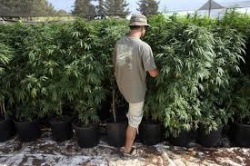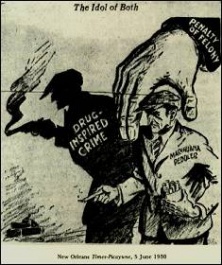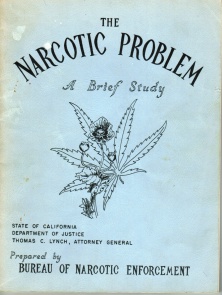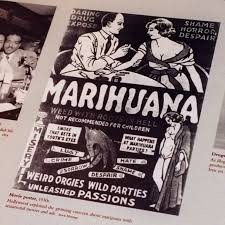Difference between revisions of "Cannabis"
(prohibition parallel) |
|||
| Line 13: | Line 13: | ||
[[image:marijuana_brief_study.jpg|left|222px]] | [[image:marijuana_brief_study.jpg|left|222px]] | ||
[[image:marijuana movie poster.jpg|right|312px|thumbnail|An anti-marijuana movie poster]] | [[image:marijuana movie poster.jpg|right|312px|thumbnail|An anti-marijuana movie poster]] | ||
| − | Cannabis has a long history of use stretching back into pre-history. However, it was not widely used as an intoxicant in USA until the early 20th century. Cannabis was subject to a devoted campaign by [[Harry Anslinger]]. | + | Cannabis has a long history of use stretching back into pre-history. However, it was not widely used as an intoxicant in USA until the early 20th century. Cannabis was subject to a devoted campaign by [[Harry Anslinger]]. The propaganda materials were not only explicitly racist, but so false as to be laughable from a modern perspective - but since the US public was unfamiliar with the drug, the [[Federal Bureau of Narcotics]] was successful at demonizing it. |
| + | |||
| + | Several scholars have claimed that [[Andrew Mellon]], who created the Bureau of Narcotics and put Anslinger in charge of it, may have been motivated by a desire to prevent a fall in his investments in the US timber industry. The legislation against cannabis applied equally to hemp (which has minimal psychoactive purposes), which was starting to become a potential rival to the long established use of wood pulp to produce paper. If true, this is a close parallel with [[John D. Rockefeller]]'s support of [[alcohol prohibition]] as a means of preventing ethanol threatening his petroleum monopoly. | ||
==Medical Marijuana== | ==Medical Marijuana== | ||
Revision as of 07:10, 13 September 2016
 | |
| Type | plant, drug |
| Interest of | • Sue Grey • Martin A Lee • Bob Marley • Salem News |
| Easily grown around the world, with a long history of medical and recreational use, 'weed' is the world's most popular recreational drug. | |
Official narrative
The DEA’s position on marijuana has remained relatively unchanged since 2011, when it produced The DEA Position on Marijuana[1] which ignored the range of long established medical uses and cited “getting arrested,” “gum disease” and “disobedience” as evidence of the drug’s harm.
History
Cannabis has a long history of use stretching back into pre-history. However, it was not widely used as an intoxicant in USA until the early 20th century. Cannabis was subject to a devoted campaign by Harry Anslinger. The propaganda materials were not only explicitly racist, but so false as to be laughable from a modern perspective - but since the US public was unfamiliar with the drug, the Federal Bureau of Narcotics was successful at demonizing it.
Several scholars have claimed that Andrew Mellon, who created the Bureau of Narcotics and put Anslinger in charge of it, may have been motivated by a desire to prevent a fall in his investments in the US timber industry. The legislation against cannabis applied equally to hemp (which has minimal psychoactive purposes), which was starting to become a potential rival to the long established use of wood pulp to produce paper. If true, this is a close parallel with John D. Rockefeller's support of alcohol prohibition as a means of preventing ethanol threatening his petroleum monopoly.
Medical Marijuana
Marijuana is proven to be effective at treating a number of medical issues, including some for which no pharmaceutical medicine is available. Started in USA in 2014?[citation needed] Marijuana has been legalized by a number of US states.
DEA's Profiteering
Jesse Ventura termed the DEA "Judge and Jury on Marijuana", after their unilaterally decision that cannabis should remain in the same legal classification as heroin - deadly, addictive and with no known medical value. As he observed, it was obvious that they would do this, to protect their income stream.[2]
Related Document
| Title | Type | Publication date | Author(s) | Description |
|---|---|---|---|---|
| File:Cannabis comparative risk assessment.pdf | Report | 30 January 2015 | Jürgen Rehm Dirk Lachenmeier | Comparative risk assessment of alcohol, tobacco, cannabis and other illicit drugs using the margin of exposure approach |



